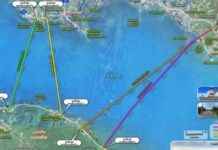Investors from Unnamed Countries Increasing Land Ownership on Koh Chang Island
A ferry departs from Koh Chang, one of Trat’s most popular destinations. (Photo: Jakkrit Waewkraihong)
National parks chief Chaiwat Limlikhit-aksorn has expressed concern about an increase in land acquisitions on Koh Chang in Trat province by investors with suspected links to shady businesses. Mr Chaiwat, who serves as the director of the National Parks Office under the Department of National Parks, Wildlife, and Plant Conservation Centre, said private investors have bought large areas of land from locals. “Some investors are alleged to have links with shady businesses,” Mr Chaiwat said. “The government and local officials must keep an eye on them.”
Large firms have been expanding their businesses on the island, affecting local enterprises which are gradually fading away. “Local consumers are turning to goods and services and modern conveniences offered by big businesses,” he said. Regarding measures to combat encroachment on protected land in national parks, he said modern technologies and satellite images are used to monitor and deter land encroachment. He said Koh Chang is largely covered in rainforests and mountains, which provide fresh water for residents on the island, compared to other islands which have to buy fresh water supplies from outside. “Local communities and agencies should work together to protect and preserve the forests and the natural environment on the island to ensure sustainable water resources,” he said.
With development and tourism increasing on the island, it is also important for residents and businesses to retain cultural uniqueness and local identity to boost appeal to tourists, he said. Asked to explain how to handle jet-skiing activities around the Koh Chang National Marine Park, he said the national marine park is made up of an archipelago of 52 islands covering 650 sqkm or more than 400,000 rai. Koh Chang is the largest island. These islands are conservation areas where only limited tourism is allowed. They are off-limits to activities such as jet-skiing, he said.
“We have to consider where jet-skiing takes place — on private property or the national park’s areas. If people jet-ski in public reservoirs, they could be in trouble. But generally, jet-skiing is part of tourism activities,” he said. Koh Chang, or “Elephant Island” because of its elephant-like shape, is Thailand’s third largest island after Phuket and Samui. It is located about 300km east of Bangkok, in Trat province, in the Gulf of Thailand. Chaiwat: We must retain our local identity
Koh Chang Island: A Hidden Gem in Thailand
Koh Chang Island, also known as “Elephant Island” due to its unique shape resembling an elephant, is a hidden gem in Thailand’s tourism landscape. Located about 300km east of Bangkok in Trat province, in the Gulf of Thailand, this island has been gaining popularity among tourists seeking a more serene and natural getaway compared to the bustling cities of Phuket and Samui.
The island’s lush rainforests and mountains provide a picturesque backdrop for visitors looking to immerse themselves in nature. With fresh water sources abundant on the island, residents and tourists alike can enjoy the pristine environment that Koh Chang has to offer. However, recent concerns have been raised about the increase in land acquisitions by investors from unnamed countries, raising questions about the future development and preservation of the island.
Investors with Suspected Links to Shady Businesses
National parks chief Chaiwat Limlikhit-aksorn has raised concerns about the surge in land acquisitions on Koh Chang by investors suspected to have links to shady businesses. These private investors have been purchasing large areas of land from locals, leading to the expansion of big businesses on the island. This trend has raised alarms about the potential impact on local enterprises, which are facing challenges in competing with these larger firms.
Mr. Chaiwat emphasized the importance of government and local officials keeping a close watch on these investors to ensure that the island’s natural resources and environment are protected. He highlighted the need for collaboration between local communities and agencies to safeguard the forests and maintain sustainable water resources on Koh Chang.
Preserving Cultural Uniqueness and Local Identity
As development and tourism continue to grow on the island, Mr. Chaiwat stressed the significance of retaining Koh Chang’s cultural uniqueness and local identity. By preserving these aspects, residents and businesses can enhance the island’s appeal to tourists while maintaining its authenticity and charm.
Jet-Skiing Activities and Marine Conservation
One of the challenges faced by authorities is managing jet-skiing activities around the Koh Chang National Marine Park. This conservation area, comprised of an archipelago of 52 islands, prohibits certain activities like jet-skiing to protect its natural resources. While tourism is allowed in limited capacities, it is essential to strike a balance between promoting tourism and preserving the marine ecosystem.
Mr. Chaiwat emphasized the need to monitor and regulate activities like jet-skiing to ensure they do not harm the environment or disrupt the conservation efforts in place. By enforcing guidelines and restrictions, authorities can maintain the ecological balance of the national marine park while still allowing visitors to enjoy its beauty responsibly.
Looking Ahead: Sustainable Development and Environmental Conservation
As Koh Chang Island continues to attract investors and tourists, it is crucial to prioritize sustainable development practices and environmental conservation. By implementing measures to protect the island’s natural resources and cultural heritage, authorities can ensure that Koh Chang remains a pristine destination for future generations to enjoy.
In conclusion, the increase in land ownership by investors from unnamed countries on Koh Chang Island raises important questions about the balance between development and conservation. With the guidance of national parks chief Chaiwat Limlikhit-aksorn and the collaboration of local communities and agencies, it is possible to safeguard the island’s unique ecosystem and preserve its cultural identity for years to come. As Koh Chang navigates the challenges of modernization and tourism, it is essential to prioritize sustainability and responsible tourism practices to ensure the island’s long-term prosperity.




















